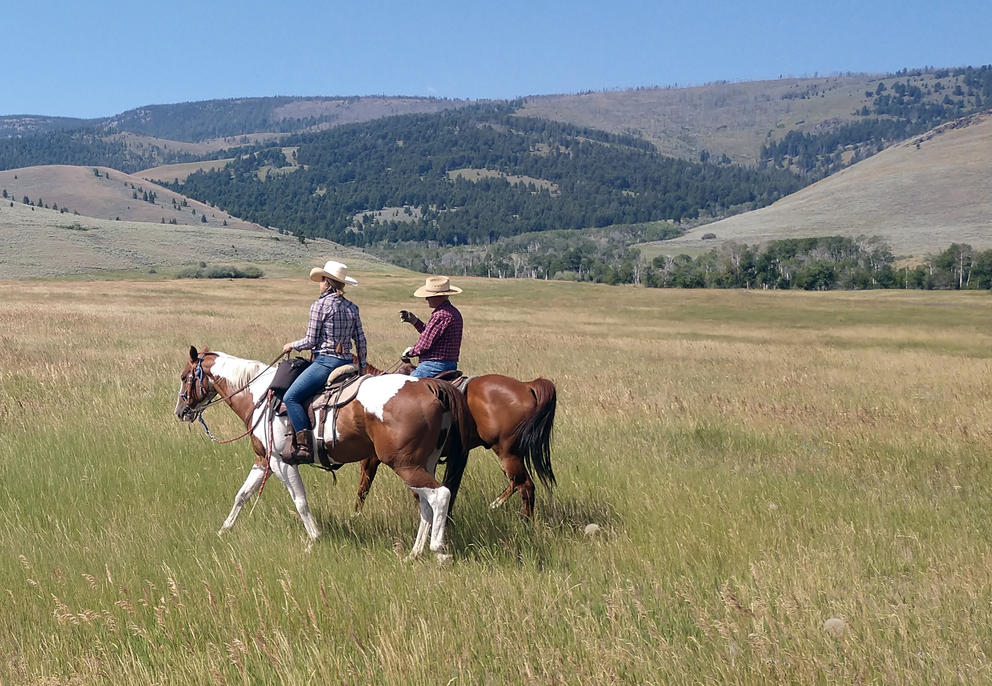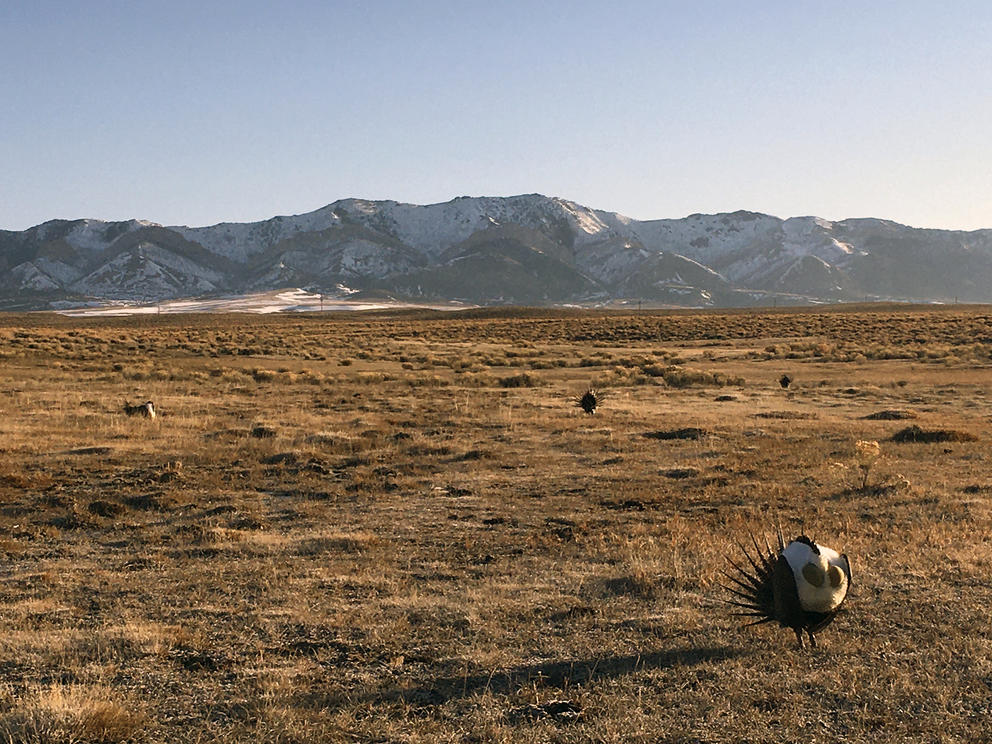It’s also a story of how Ahearn worked her way through endearing trial and error into the rural Methow Valley, where she moved two years ago to escape Seattle’s liberal bubble and see more of the outside world she had reported on as a radio environmental journalist. “Grouse,” which launched Sept. 15, explores why it’s so hard for people to agree on how to protect the bird, but it’s also about how humans relate to each other in a time when Americans are fundamentally split on how to live. Ahearn records her experiences with people from all walks of rural life: scientists, ranchers, oil executives, environmentalists.
“There’s no species that better reflects our Western experience better than sage grouse,” a source tells her in the podcast’s first episode. What happens to them, another source tells her, is what will happen to us as people.
Crosscut spoke with Ahearn about producing a podcast like “Grouse,” and what it taught her about her new neighbors and the bird at the heart of so much conflict.
This interview has been edited for length and clarity.
CROSSCUT: Why did you move to the Methow Valley?
Ahearn: I was tired of city life. And as an environment reporter, over the years, it felt like I was inside a bubble and preaching to the choir; covering stories about natural resources and wild things from the city didn't feel completely true or representative of the communities that live closer to those resources and actively interact with them. I wanted to be more in community with the people that are kind of living climate change first hand — whether or not they believe the science.
Why sage grouse?
A good friend of mine who's a writer said, “We tried for years to make the sage grouse story interesting. And we just couldn't do it.” It's this obscure bird that most people will never see, that doesn't have any economic value and isn’t a linchpin of the ecosystem. I kind of took that as a personal challenge. I was like, I'm going to make it not a boring story. I'm going to find out everything I can about this bird.
As I've gotten older, I think there's been a lot of learning for me about how hard it is to keep caring and keep engaging with environmental content. So with “Grouse,” I was using my personal story, mining my own experience as a newcomer to sage grouse country and my flailings around, frankly, trying to figure that life out as a way to be a proxy for the listener who might be curious but [staying away], maybe for self-protective reasons — like I did for years as a journalist covering these issues. Having your heart broken open is something maybe a lot of us don't have much more energy for right now. But I'd rather live heartbroken and raw and open than numb and closed.
And the truth is, the more you learn about something, as with anybody who has a hobby or a passion, the more you find yourself sort of falling in love. It's hard not to when you really understand something. Can I tell you just this really cool thing about sage grouse?
Please do.
When they're on the lek, the males inflate air sacs [on their chests] and run their wings up and down the sides of them to make them seem bigger. It makes this swishing sound like the warmups people wore in the ’80s. And I will never forget [biologist] Michael Mike Schroeder explaining the swishing sound: It's these tiny pin feathers that are very stiff on the sides of those air sacs that make this swishing sound when they rub against the wings. I didn't realize what a made-for-audio story I was walking into until I heard my first sage grouse lek up close.
Just learning the granular detail about how that sound was made, through the eyes of a scientist who's been studying those birds for decades, and then experiencing it myself like that — that to me is falling in love. It's like when you get to know somebody early in a relationship, and they tell you some story from their childhood or something that's just really telling about their character, and you love them that much more for being like, “Oh, I can see you as like a little boy, when this happened to you and you behaved this way.”
But it was a gradual courtship. I would say I was not in love with the birds when I started this series. I did not come into this like, “We need to save the sage grouse.” I came into this series wanting to see if I could make myself care again, frankly — if I could come through my own numbness to fall in love with these birds as a way of kind of, I don't know, recovering.
After all of your reporting, what’s your take on the bird’s situation in Washington?
Washington is the Ghost of Christmas Future for sage grouse. The bird is threatened for a lot of different reasons across its range. In Wyoming, it's more of a threat from oil and gas extraction. In Montana or other places, it's maybe more overgrazing. Here in Washington, it was more development — the changing or transitioning of wild sagebrush habitat to wheat fields to farms and homesteads. And I think as more and more people move into the West, though, there will be more people trying to live outside of the city, and I wonder if our generation is going to be that next back-to-the-land type movement after the virus and everything. And so looking at the threats to the bird, development is the big one in Washington. I think that the reality is the story across the range is one of a downward trend, with some glimmers of hope or holdout pockets of the populations. It doesn't mean there aren't a lot of people working to try to stop that and turn that trend around.
What did befriending your neighbors teach you about people at the heart of sage grouse tensions?
Breaking bread, herding cows, drinking, clearing trails, working the land together and learning from really conservative gun-toting ranchers and cowboys has been ... it doesn't make me OK with some of the stances that they have about the current issues that we're talking about as a country, but I think it's become harder and harder to box them all up and make generalizations.
You see firsthand how entwined the folks out here are with the land. And that's something that I think city people maybe don't realize. It’s easier to think they’re extracting from the land as opposed to managing it and living with it. And that's not to say that there aren't bad eggs in any group of people. But ranchers that I've met have a conservation ethic that is unmatched by some of the city slickers driving their, you know, Subarus with low gas mileage. I don't mean to point fingers. And it's not about saying anybody's better than anybody else. It's just about having a renewed empathy for people who are living closer to the land and the challenges that that brings.
What role did science play in how you told the story of sage grouse?
Reporting on the environment can be wonderful and immersive and beautiful, and allows you to take people places. But the truth is, I'd rather take people places with scientists, because I think they see the world in such a clear and earnest way. You're not trained as a scientist to be vulnerable — but the scientists that I've chosen to feature here brought their whole heart to this series. And I think as a result, you get more light than heat, you get people who are truly able to present the data and can show their passion and their conclusions from that data.
And usually, I think the conversation stops for many scientists with presenting the data and then leaving it there for us to figure out. I don't think we live in a time where they have that luxury anymore. I think a lot of scientists are waking up to that.
Heading into another election, how do you feel about your understanding of rural America?
I wish I could tell you this was a podcast about bridging the urban-rural divide or the liberal-conservative divide. I feel like I'm able to do that on the individual level, through friendships that I've made here through hard work and shared experience and shared commitment to this community and the land and the people here. That's something I'm always wrestling with: Is it a betrayal of my belief system to be friends with these folks sometimes when I think that some of the things that this president has done are reprehensible, and some of the beliefs that he espouses are hurtful?
I think I've [developed] more of a softness, and maybe at least found context for where some of these beliefs come from. Whether it's a little bit of xenophobia or lack of trust of newcomers or outsiders. But I don't lie to myself that I'm going to change their opinions. I think that the most I can hope for is that, when my conservative friends start saying disparaging things about liberals, they picture me.
So as I look ahead to this next election, I hope that it doesn't tear us apart. These friendships mean a lot to me. I'm still going to vote the way I'm going to vote, and they're going to vote the way they're going to vote. And if a wildfire comes through, I know they're going to come and help me the same way that I'm going to go and help them. I don't use the word “hope” anymore, but there's at least some solace in that. But I won't use the word “compromise” or “agreement” anymore.
What’s next for you?
Journalism is academia for the ADHD crowd. So will I always love sage grouse? Yes, 150%. Will I continue covering them? I mean, yeah, if there's a big news event. But this is the body of work that I want to do about this topic. I'm going to be turning my attention to a big series on women and ranching. I'm in it for the long haul [here]. And I think covering ranching communities, rural communities is something that we need more journalists doing.
[I've reached a] sort of landing point of where my personal philosophy is right now on conservation issues: You do everything you can, try to walk as lightly as you can, with the understanding that you live within a system and you didn't create the system and you can work to try to change it — pick a cause.
But some of these systems are outside of our control. For me, it's come down to living every moment and cherishing the time that I have had with these birds and the physical labor of my life now and being present fully every day in my body on the landscape.
Ahearn produced Grouse in partnership with BirdNote and Boise State Public Radio. It will air on NPR stations in ID, MT, WY, UT and NV via the Mountain West News Bureau. It's also available in podcast apps or by clicking here.





